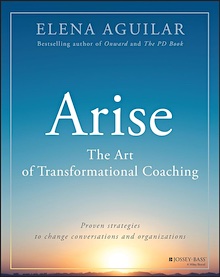Who Are You to Tell Me What to Do?
By Elena Aguilar
 It’s all about the relationships. I know this intellectually, and from experience, and yet there’s nothing like the visceral reminder when an 8th grader stares you down that middle school kids are reluctant to learn with those they don’t know or trust. Jefferson reminds me with his stare. He challenges me: who are you, lady, to tell me what to do?
It’s all about the relationships. I know this intellectually, and from experience, and yet there’s nothing like the visceral reminder when an 8th grader stares you down that middle school kids are reluctant to learn with those they don’t know or trust. Jefferson reminds me with his stare. He challenges me: who are you, lady, to tell me what to do?
It had been four years since I’d stood in front of a class of kids as their teacher. I decided to return to that position, only for a week, for many reasons: to model skillful teaching for the first year teacher, to “walk the walk,” to build my credibility amongst a group of teachers I work with, and to remind myself again what it’s like to teach middle schoolers—an empathy tune-up.
I had taught middle school for eight years (after teaching high school and elementary for five years). I loved my passionate, whacky, thirsty students, but I saw so many other teachers struggling. “How do you get your kids to do what they do?” teachers would ask me. So I became an instructional coach.
This opened up another set of questions: What are the conditions necessary for teachers to be effective with middle school students? What role does the principal play? What kind of support does the principal need in order for his teachers to be effective with their students? Which systems need to be in place in order for high quality learning to happen?
These wonderings led me to become a leadership coach. Currently I lead a team of instructional and leadership coaches who work in four middle schools in Oakland, California, providing an unprecedented level of support to teachers and administrators.
This is so hard
I’ve been missing the art and craft of teaching, the thrill of working with students. So I asked Alison, the new eighth grade history teacher, if I could teach her class for a week. She was thrilled. I got really nervous. I spent weeks planning (wow! I’d forgotten how long planning took!) I had anxiety dreams and first-day-of-school jitters.
And then, there was Jefferson, staring me down.
Alison had warned me: “All of the eighth grade teachers struggle with Jefferson. He refuses to do anything. He’s defiant. I’m sure he’ll call you a bitch before the end of the period—he never makes it through class without getting a referral.” I did some research on Jefferson. He reads at a second grade level, he missed 25 days of school last year, and he attended four different elementary schools. “What does he like to do?,” I asked Alison. “What are his strengths?” Drawing, she said.
So I brought a few cool drawing pencils for Jefferson. Just a token, a nod of acknowledgment. I stood at the door as kids arrived and greeted them, shaking their hands. Jefferson arrived just after the bell rings. Looked at me warily. Took his seat.
I started my introduction which I’d mentally rehearsed for weeks. I wanted to ask students to engage in some challenging learning during the week I’d be with them—analyzing primary sources, developing arguments, reading complicated text—but before I could do that I needed to quickly hook them into me and what I would offer.
Their flat stares and expressionless faces reminded me that it’s all about the relationship. Between me and them. Between the students. Within just five minutes, I was humbled. Who did I think I was that I could incur their trust that fast? I wanted to bow down to the teacher—Oh, yes, this is so hard, I remembered.
This kid had been hurt before

“Hey, Jefferson. Come on back to your seat,” I said in a soft, solid voice. He just looked at me. “I’d like you to make a choice,” I said. “I’ll give you a minute or two to do so.” I walked away, talked to another student. Moved the lesson along. Three minutes later he wandered back to his seat, one eye on me at all times it seemed. But then he shouted across the room to another student. One eye watching me to see how I’d react.
Again, I reacted slowly, deliberately. No urgency, no panic. I know he’s used to getting a quick reaction from teachers. I moved through the clusters of desks to his. I crouched down, way down, so that I was looking up at him. This was intentional. I tried to communicate non-verbally: I’m not going to hurt you, kid. I’m not going to play power games.
This kid had been hurt before—I knew this immediately—I felt it in some teacher-organ that’s not yet discovered. Given that he reads at a second grade level, his learning needs clearly have not been attended to. There was no reason for him to trust teachers or school or me.
I let him tower over me, but in my soft, solid voice I said this: “Jefferson, it’s okay with me if you make choices about today. If you want to engage in this lesson, that’s great. If you choose not to, that’s also fine. However, you can’t detract from anyone else’s learning. You can’t bother those who are choosing to engage. Okay?”
He just stared at me. “I heard that you like art,” I continued. “I brought you some pencils to use if you’d like. We are going to be doing some sketches later. Can I give them to you?” He shook his head. “Okay,” I responded, getting up, “Let me know if you want them.” I very quickly, very lightly touched his forearm. Before he could react, my hand was gone and I’d moved away.
What I really wanted to do was hug him and apologize for whatever has happened that made him be so hard and distrusting.
The need for deep levels of trust and learning
Most of the students did what they were asked on this first day. My lesson was well-structured, within their zone of proximal development, and the content was compelling. They complied, but they were wary—I felt it. Jefferson tested me a few times and got a couple of warnings, but he didn’t get a referral and didn’t call me a bitch. On day five he accepted the art supplies I’d brought him.
This experience propelled me into reflecting on how I formed relationships with students and to how long that took. As a classroom teacher, I’d had the opportunity several times to loop with my students. The months of relationship building paid off and in year two we reached deep levels of trust and learning. Other structures such as advisory, student-led conferences, and “fieldwork” (an extension of field trips) also facilitated the building of trusting relationships.
There is a set of skills that teachers can develop which lead to strong relationships with students, there’s no doubt about that. But there are also structures and systems which need to be in place in a school in order to facilitate that.
Without supportive structures, we won’t improve schools
In the school where I “guest taught” recently, teachers see 140 students per day. Class periods are 50 minutes long. There are few structures that enable relationships to develop between adults and children, or between the kids themselves. I realized that I would never teach in a school like this—the foundation for developing relationships doesn’t exist, and I can’t teach without relationships. I did it for five days—Jefferson was only one of a dozen who continuously tested me—and it was exhausting.
I remembered that as a teacher, once I’d established boundaries, trust, and respect with my students, the constant testing ceased. My energy wasn’t being sucked into classroom management. But given the structures at this school, I’m not sure that would ever happen. How can a teacher possibly develop deep, meaningful connections with 140 eighth graders? Especially when she sees them in groups of 32, for 50 minutes at a time?
And yet, I know this is the reality for so many teachers. My empathy has definitely been tuned up and I’m reminded, again, that real school transformation must address, and perhaps start with, the systems and structures in which we work. And I’d argue that those must be designed and implemented with the primary goal of facilitating relationships between teachers and students, and between students themselves.

Elena is the author of eight best-selling books, including her latest, Arise: The Art of Transformational Coaching (2024); The PD Book: 7 Habits That Transform Professional Development (2022); Coaching for Equity: Conversations That Change Practice (2020); The Art of Coaching Teams: Building Resilient Communities That Transform Schools (2016); and The Art of Coaching: Effective Strategies for School Transformation (2013).






























Great concept of recognizing that a hurt child isn’t always acknowledged. In my children’s middle school, a grandparent was trying to explain to the principal that her grandson had been abused and the teachers behavior was seen as aggressive to him. She was hurt. He laughed at her and told her that her grandson needed to learn to please the teachers. The leadership of our schools here is really poor.
Gloria
Good information that goes across all grade levels. I have a student in Kindergarten that tests me the same way that Jefferson tested you. After teaching 17 years, it really is about “building relationships”.